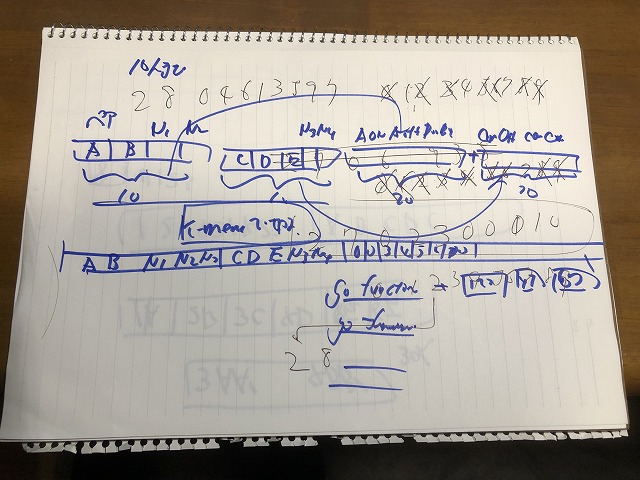長女:「世の中には、『正義と悪』という基準と『好きと嫌い』という基準の2つがある、って、誰かが言っていた」
Daughter: "Someone once told me that there are two standards in the world: 'justice and evil' and 'like and dislike'"
江端:「それは違うな。『好きと嫌い』という基準が1つあるだけだ」
Ebata: "That's not true. There is only one standard, 'like and dislike'"
長女:「『正義と悪』はないの?」
Daughter: "Isn't there a 'Justice and evil'?
江端:「『正義と悪』は、所詮は相対的な概念だ。立ち位置によって、簡単に180度ひっくり返るものであるから、私は、あまり重要とは思っていない」
Ebata: "'Justice and evil' is just a relative concept. It can be easily turned 180 degrees depending on where we stand, so I don't think it's very important.
-----
まあ、もっとも『絶対的正義』というものを求めて、古今東西多くの哲学者が死ぬほど考えて抜いてきたことは、私も知っています。
Well, I know that many philosophers in the past and the present have thought to death in search of the most 'absolute justice'.
しかし、死ぬほど考えなければ分からないものであるなら、それを共通の価値基準に置くのは、酷く面倒くさい上に、逆に「危い」とさえ思っています。
But if it's something we have to think about to death to understand, I think it's terribly tedious and even "dangerous" to put "absolute justice" as a common value standard.
-----
江端:「そもそも、法治国家における法治 ―― まあ、裁判はその一例だが ―― この運用がどのように行われるかしっているか?」
Ebata: "To begin with, do you know how the operation of the rule of law in a country under the rule of law is carried out? Well, the trial is just one example"
長女:「『主観を排して、証拠と法に基いてのみ人間を裁くこと』でしょう?」
Daughter: "To judge a person only on the basis of evidence and law, without 'subjectivity' right?
江端:「それは建前だ。この話は、法学ゼミで教えて貰って、私自身も仰天したことだが ――」
Ebata: "That's a pretext. This story was taught to me in law seminar, and I myself was astonished...."
といって、私は裁判のプロセスを語り出しました。
Then I started to talk about the process of a trial.
-----
(Step.1) 裁判官は、主観で被告の「好きと嫌い」を決めて、有罪/無罪および、その刑量をざっくり思い浮かべる。
(Step.1) The judge decides on the subjective "likes and dislikes" of the defendant and comes up with a rough idea of guilt/innocence and the amount of the sentence.
(Step.2) 次に裁判官は、この有罪/無罪、および刑量を導き出すための、複数の法律の条文を頭の中で並べる
(Step.2) The judge then lays out in his or her mind the multiple articles of law from which to derive this guilt/innocence and sentence amount.
(Step.3) 裁判官は、これらの条文を、担当事件の内容に当てはめられるかどうかを検討する。上手くはまれば、判決に適用する
(Step.3) The judge considers whether these articles can be applied to the case in question. If it works, they apply it to the judgment.
-----
江端:「でもって、上記(Step.1)~(Step.3)は、裁判官だけでなく、検察、弁護人も共通認識として共有している。そんでもって、この3者の関係者が、判決の落とし所を擦り合わせていく ―― これが、基本的な裁判のアプローチだ」
Ebata: "The above (Step.1) to (Step.3) are shared by not only judges but also prosecutors and defense attorneys. Then, these three parties work together to reach a decision. This is the basic trial approach.
長女:「うそ・・・」
Daughter: "No way..."
江端:「勿論、上記は、状況証拠も物的証拠も明らかであって、かつ、民事裁判のケースの話になるけど、ここに情状酌量の余地とか、世論の動向とか、社会通念とかをつっこんで、『この被告を、どこまで許せるか』という主観的基準で判決はされるんだよ」
Ebata: "Of course, the above is a civil case with clear circumstantial and physical evidence, however, they can add extenuating circumstances, trends in public opinion, and social norms. And finally, the judgment is made based on the subjective standard of "How much can I forgive this defendant?""
長女:「『正義と悪』が基準ではないんだ・・・」
Daughter: "'Justice and evil' is not the standard...
江端:「『正義と悪』は、『好きと嫌い』の理由付けとして存在している『道具概念』だ」
Ebata: "'Justice and evil' is a 'tool concept' that exists as a rationale for 'like and dislike'."
長女:「ならば、法律の存在意義がないじゃんか?」
Daughter: "Then what is the point of the law's existence?
江端:「いやいや、大切なのは「たとえ『好きと嫌い』から出発しても『好きと嫌い』だけを理由には判決はできない」、という、この一点にある」
Ebata: "No, no, the important point is this: 'Even if they start from 'like and dislike', they can't make a judgment based only on 'like and dislike'".
長女:「?」
Daughter: "?
江端:「どんな法律でもいいけど、必ず明文化された法律に基づいて論理的に(見せかけて)判決を出さなければならない ―― これが法治の理念で、最後の砦でもある」
Ebata: "It doesn't matter what kind of law they use, but they must always make a logical (pretend) judgment based on a clearly stated law -- this is the principle of the rule of law, and it is also the last resort."
-----
まあ、そういう意味において、「遠山の金さん」は、『好きと嫌い』だけで、しかも独断で判決をしていた訳ですから、考えてみれば、背筋の凍るような恐しい裁判方法だった訳ですよ。
In that sense, "Toyama no Kin-san" made judgments based on "likes and dislikes" alone, and at his own discretion.
私としては、「遠山の金さん」は、間違いなく「冤罪製造システム」として機能してきたと思んです。
As for me, I think that "Toyama no Kin-san" has definitely functioned as a "false accusation manufacturing system".
そんな訳で、私は、
That's why I want to watch a TV drama whose title is
―― 「遠山の金さん "冤罪"捕物帳」
"Tozan no Kin-san, the 'False Accusation' Catcher's Notebook"
というドラマを見たいんですよね。
